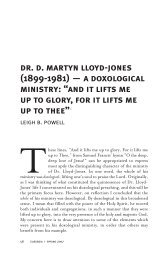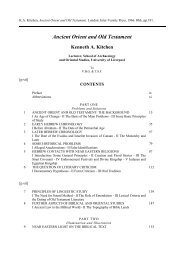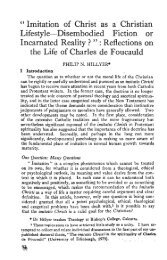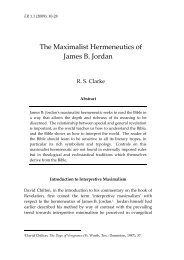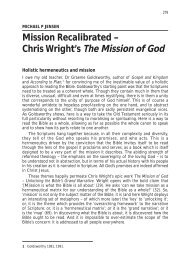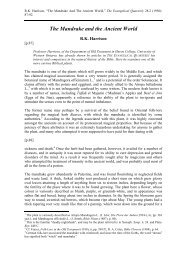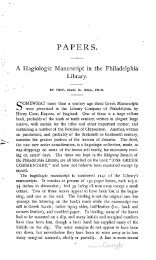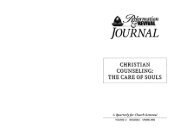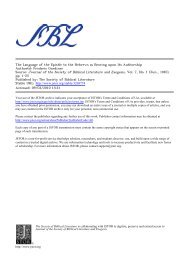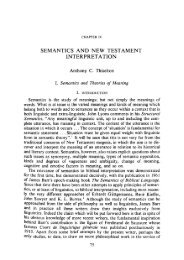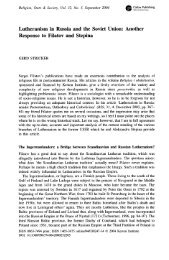Margaret Brearley, "Matthew Fox and the Cosmic Christ," Anvil 9.1
Margaret Brearley, "Matthew Fox and the Cosmic Christ," Anvil 9.1
Margaret Brearley, "Matthew Fox and the Cosmic Christ," Anvil 9.1
You also want an ePaper? Increase the reach of your titles
YUMPU automatically turns print PDFs into web optimized ePapers that Google loves.
<strong>Mat<strong>the</strong>w</strong> <strong>Fox</strong> <strong>and</strong> <strong>the</strong> <strong>Cosmic</strong> <strong>Christ</strong><br />
~GARETBREARLEY<br />
The myth of matricide<br />
<strong>Mat<strong>the</strong>w</strong> <strong>Fox</strong>, an American Dominican, is a prolific <strong>and</strong> controversial<br />
author, whose 'creation spirituality' is gaining wide influence within both<br />
Roman Catholic <strong>and</strong> Anglican churches <strong>and</strong> retreat centres. To review his<br />
recent book, The Coming of <strong>the</strong> <strong>Cosmic</strong> <strong>Christ</strong>: The Healing of Mo<strong>the</strong>r Earth <strong>and</strong><br />
<strong>the</strong> Birth of a Global Renaissance (Harper& Row, San Francisco 1988) is an even<br />
more complex task than reviewing his earlier writings, for it is somewhat<br />
like a hologram; its beginning, entitled: 'Prologue: A Dream <strong>and</strong> a VISion',<br />
already contains its end; each segment of <strong>the</strong> text is interdependent on <strong>the</strong><br />
rest <strong>and</strong>, in a sense, contains <strong>the</strong> whole. Ra<strong>the</strong>r than developing thought <strong>and</strong><br />
argument in logical progression, <strong>the</strong> book represents shafts of light thrown<br />
from different perspectives on one central image or myth. For <strong>the</strong> first time<br />
<strong>Fox</strong> has constructea an all-embracing myth which he believes is capable of<br />
explaining <strong>the</strong> totality of contemporary reality. He <strong>the</strong>n demonstrates a new<br />
ethic, derived from that myth, <strong>and</strong> finally dem<strong>and</strong>s that an utterly new<br />
reality be formed on <strong>the</strong> basis of his central myth <strong>and</strong> its ethic.<br />
The dominant myth is that of matricide. <strong>Fox</strong> accuses traditional <strong>Christ</strong>ianity<br />
- <strong>and</strong> <strong>the</strong>refore Western culture - of being matricidal. In earlier<br />
writings he had already radically condemned <strong>Christ</strong>ian orthodoxy.<br />
While claiming to restore <strong>the</strong> Hebrew roots of <strong>Christ</strong>ianity, <strong>Fox</strong> had in fact<br />
rejected both <strong>the</strong> God of Israel <strong>and</strong> traditional prayer as 'useless' <strong>and</strong> denied<br />
both Old <strong>and</strong> New Testaments as sources of revelation. 1 In The Coming of <strong>the</strong><br />
<strong>Cosmic</strong> <strong>Christ</strong> <strong>Fox</strong> is even more radical. Merely on <strong>the</strong> basis of a prophetic<br />
'dream' in which he heard a voice saying 'Your mo<strong>the</strong>r is dying', <strong>Fox</strong><br />
describes <strong>the</strong> entire Western culture as 'involved in a matricide which is also<br />
ecocide, geocide, suicide <strong>and</strong> even deicide'. (p 17) The anima is dying;<br />
wisdom, creativity, youth, love, native peoples, Mo<strong>the</strong>r Church - all are<br />
dying. But, above all, it is Mo<strong>the</strong>r Earth who is raped, tortured, crucified: 'We<br />
have begun to put our h<strong>and</strong>s in her lanced side <strong>and</strong> in her crucified h<strong>and</strong>s<br />
<strong>and</strong> feet'. (p 16) Mo<strong>the</strong>r Earth's murderer is <strong>the</strong> patriarchy of western<br />
civilisation, of dualistic <strong>Christ</strong>ianity, above all of 'fundamentalism', which is<br />
'patriarchy gone berserk'. (p 27) Whereas Mo<strong>the</strong>r Earth is portrayed as<br />
almost human, 'very aware <strong>and</strong> sensitive', (p 18) <strong>the</strong> Church has become<br />
inhuman. Dominated by patriarchal <strong>the</strong>ology <strong>and</strong> fundamentalism, <strong>the</strong><br />
Church is now matricidal <strong>and</strong> sado-masochistic. (p 28) Because of his dream,<br />
1 M. <strong>Fox</strong>, On Becaming a Musical Mystical Bear, (Paulist Press, New York 1972, 1976), pp<br />
19, 26, 62. Cf. M. <strong>Brearley</strong>, '<strong>Mat<strong>the</strong>w</strong> <strong>Fox</strong>: Creation Spirituality for <strong>the</strong> Aquarian Age',<br />
<strong>Christ</strong>ian Jewish Relations, vol. 22 (1989), pp 37-49.<br />
39
<strong>Anvil</strong> Vol. 9, No. 1, 1992<br />
<strong>Fox</strong> describes <strong>the</strong> 'fundamentalist forms of <strong>Christ</strong>ianity', to which he applies<br />
Doro<strong>the</strong>a Soelle' s term of '<strong>Christ</strong>ofascism', as imbued with 'a reptilian kind<br />
of energy <strong>and</strong> hatred' <strong>and</strong> 'reptilian language'. (p 28)<br />
This dehumanising portrayal of <strong>the</strong> Church is perhaps <strong>Fox</strong>'s revenge on<br />
<strong>the</strong> Vatican for silencing him for one year on grounds of heresy. But it is<br />
actually crucial to his spirituality. For <strong>Fox</strong> proclaims <strong>the</strong> 'good news' to <strong>the</strong><br />
Church that out of <strong>the</strong> crucifixion of Mo<strong>the</strong>r Earth will come a spiritual<br />
awakening 'from Mo<strong>the</strong>r Earth herself'. (p 18) As <strong>the</strong> Church separates from<br />
'fascist religious sects', it will awaken at last to compassion <strong>and</strong> be reborn:<br />
'those who are engulfed in mo<strong>the</strong>r church's womb need to be born again in<br />
<strong>the</strong> womb of mo<strong>the</strong>r cosmos. This second birth is crucial for <strong>the</strong> redemption<br />
of <strong>the</strong> Church'. (p 32)<br />
The revival of mysticism<br />
<strong>Fox</strong> declares that Western matricide has involved a 'dangerous ... denial of<br />
<strong>the</strong> mystic', (p 39) which has led to a 'depressive' culture. In one of his<br />
intuitive semantic leaps into sweeping generalisation, he <strong>the</strong>n states: 'a<br />
civilisation that denies <strong>the</strong> mystic is no civilisation at all'. (p 43) But both<br />
civilisation <strong>and</strong> Church can be redeemed through a 'deep mystical awakening<br />
<strong>the</strong> likes of which <strong>the</strong> planet has never witnessed before ... an awakening<br />
in our mystical consciousness'. (p 34) Only mysticism, 'a resurrection story<br />
for our times', (p 35) can redeem humankind <strong>and</strong> <strong>Christ</strong>ianity: 'How will we<br />
move from crucifixion or matricide to healthy living? The link. .. lies in <strong>the</strong><br />
human psyche's capacity for resurrection: for aliveness, wakefulness, awareness,<br />
<strong>and</strong> rebirth- in short, mysticism. ... If we can awaken to an au<strong>the</strong>ntic<br />
mysticism, <strong>the</strong>n a resurrection of Mo<strong>the</strong>r Earth is possible'. (p 38)<br />
It is welcome that <strong>Fox</strong> in this <strong>and</strong> earlier books stresses <strong>the</strong> need for <strong>the</strong><br />
Church to rediscover mysticism. Here, as elsewhere, <strong>Fox</strong> plays a valuable<br />
role in pointing to deep lacunae <strong>and</strong> flaws within <strong>Christ</strong>ianity past <strong>and</strong><br />
present. He rightly highlights <strong>the</strong> appalling record of <strong>the</strong> Church towards<br />
Native American Indians <strong>and</strong> o<strong>the</strong>r oppressed peoples. He rightly stresses<br />
<strong>the</strong> Church's distorted teaching on sexuality <strong>and</strong> consequent history of<br />
misogyny. 2 He rightly claims that in <strong>the</strong> last three hundred years <strong>the</strong> Church<br />
has ab<strong>and</strong>oned its mediaeval neo-Platonic cosmology (though this was a<br />
necessary consequence of invaluable scientific developments). Most of its<br />
mystical traditions are little known today. Yet while few in <strong>the</strong> Church now<br />
know that mediaeval mystics understood <strong>the</strong> songs of <strong>the</strong>ir own souls,<br />
briefly but ecstatically entering <strong>the</strong> holy presence of God, as echoing both <strong>the</strong><br />
song of angels in <strong>the</strong> spiritual realm <strong>and</strong> <strong>the</strong> song of Creation within <strong>the</strong><br />
earthly realm, as it glorified its Creator,3 au<strong>the</strong>ntic <strong>Christ</strong>ian mysticism<br />
never died. From Traherne, William Law <strong>and</strong> John Wesley to Gerard Manley<br />
Hopkins, Kierkegaard, Thomas Merton, even to parts of <strong>the</strong> charismatic<br />
renewal, it has survived until today, with its emphasis on holiness, <strong>the</strong> Holy<br />
Spirit, biblical meditation <strong>and</strong> awareness of <strong>the</strong> beauty of God's creation.<br />
2 Cf. U. Ranke-Heinemann, Eunuchs far Heaven. The Catholic Church & Sexuality, Andre<br />
Deutsch, London 1990.<br />
3 Richard Rolle, The Fire of Love, trs. C. Wolters, Penguin Books, London 1972, chs. 15-<br />
17.<br />
40
MARGARET BREARLEY Milt<strong>the</strong>w <strong>Fox</strong> <strong>and</strong> <strong>the</strong> <strong>Cosmic</strong> <strong>Christ</strong><br />
But <strong>Fox</strong>'s own underst<strong>and</strong>ing of mysticism radically differs from that of<br />
traditional <strong>Christ</strong>ian mysticism, for he rejects any notion of a transcendent<br />
God into whose presence <strong>the</strong> soul can enter. He fur<strong>the</strong>r rejects <strong>the</strong> contemplative<br />
forms of prayer, fasting <strong>and</strong> biblical meditation, which virtually all<br />
<strong>Christ</strong>ian mystics have practised. 4 Mysticism means for <strong>Fox</strong> not <strong>the</strong> soul<br />
approaching <strong>the</strong> transcendent God but <strong>the</strong> immersion of <strong>the</strong> psyche into <strong>the</strong><br />
unconscious mind, into <strong>the</strong> 'great underground river' of <strong>the</strong> life force itself,<br />
where in earlier books he had located divinity. 5<br />
<strong>Fox</strong>'s mysticism is explicitly described as being identical with Aldous<br />
Huxley' s 'perennial philosophy'. (p 47) He thus follows <strong>the</strong> path which Prof.<br />
R C. Zaehner so roundly condemned: 'Unfortunately... <strong>the</strong>re are still many<br />
ra<strong>the</strong>r simple individuals who prefer to treat mysticism as a single phenomenon,<br />
identical in all its manifestations <strong>and</strong> present everywhere in <strong>the</strong><br />
world .... This is very far from <strong>the</strong> truth'. 6 For <strong>Fox</strong>, mysticism is <strong>the</strong> attainment<br />
of non-dualistic 'cosmic consciousness' through <strong>the</strong> psyche <strong>and</strong> through<br />
psycho-physiological techniques such as deep breathing, widely practised<br />
in yoga <strong>and</strong> occultism. Whereas traditional <strong>Christ</strong>ian mysticism bas been<br />
practised by an ardent, oftenasceticminoritywithin <strong>the</strong> Church-although<br />
in movements such as <strong>the</strong> late mediaeval devotio moderna <strong>and</strong> <strong>the</strong> modem<br />
charismatic renewal certain aspects of <strong>Christ</strong>ian mysticism have become<br />
widely known <strong>and</strong> used- <strong>Fox</strong>'s version of mysticism is, he claims, universal.<br />
His aim is 'to elicit <strong>the</strong> mystic within each person'; 'everyone is a mystic'.<br />
(p 48) Because mysticism is a 'right-brain experience', (p 47) 'all of life is<br />
mystical, i.e. irrational'. (p 55) Mysticism leads to rebirth, to universal<br />
creativity; as each person births <strong>the</strong> mystic through <strong>the</strong> psyche <strong>and</strong> bodily<br />
techniques, '<strong>the</strong> true self' is born, 'a birth with God of what is truly divine'.<br />
(p 64) Indeed, <strong>Fox</strong> even claims that '<strong>the</strong> earth yearns' (p 65) for his version<br />
of mysticism, since it involves <strong>the</strong> permanent eradication of all dualism,<br />
between heart <strong>and</strong> head, body <strong>and</strong> mind, above all'<strong>the</strong> primary dualismthat<br />
between humans <strong>and</strong> divinity'. (p 50)<br />
<strong>Mat<strong>the</strong>w</strong> <strong>Fox</strong> <strong>and</strong> dualism<br />
Yet here, as elsewhere, <strong>Fox</strong> is himself deeply dualistic. His creation spirituality<br />
<strong>and</strong> mysticism result from wilful dualism on his part; he has split away<br />
from what he too narrowly categorises as 'fall-redemption <strong>the</strong>ology' its own<br />
integral vision of creation, which he has <strong>the</strong>n claimed as an independent<br />
spirituality. Contrary to historical evidence, <strong>Fox</strong> denies that God-centred<br />
fall-redemption <strong>the</strong>ology has inspired mystics. He caricatures traditional<br />
main-stream <strong>the</strong>ology as non-mystical, ascetic <strong>and</strong> exclusively concerned<br />
with sacraments <strong>and</strong> liturgical rites. He claims that <strong>the</strong>re has been a separate<br />
'creation-
<strong>Anvil</strong> Vol. 9, No. 1, 1992<br />
As a mediaevalist steeped in <strong>the</strong> German mystics, I am convinced that<br />
<strong>Fox</strong>'s dualistic distinction between 'non-mystical' fall-redemption <strong>the</strong>ology<br />
<strong>and</strong> mystical creation spirituality is a deliberate fallacy. With <strong>the</strong> possible<br />
exception of Eckhart, all of <strong>Fox</strong>'s so-called 'creation mystics'- Johannes<br />
Tauler, Heinrich Suso, Julian of Norwich, Hildegard of Bingen, Mechtild of<br />
Magdeburg-were deeply rooted within both <strong>the</strong> Church's institutions <strong>and</strong><br />
<strong>the</strong> traditional God-centred <strong>the</strong>ology of sin, redemption <strong>and</strong> imitatio Dei.<br />
Their language, with its word-coinages, bold similes <strong>and</strong>- in <strong>the</strong> case of<br />
women mystics-erotic overtones, was innovative <strong>and</strong> bold, as was fitting<br />
for those trying to express inexpressible spiritual experiences. Their <strong>the</strong>ology<br />
was by <strong>and</strong> large orthodox; indeed, Hildegard of Bingen <strong>and</strong> o<strong>the</strong>r<br />
mystics willingly combatted heretics of <strong>the</strong>ir day. Their mystical experience<br />
was most certainly not rooted, as is <strong>Fox</strong>'s nature-centred mysticism, in '<strong>the</strong><br />
primal sacrament, <strong>the</strong> primal mystery that is <strong>the</strong> universe itself'. (p 39) On<br />
<strong>the</strong> contrary, it stemmed, as Kenneth Kirk demonstrated when discussing<br />
Richard of St Victor, from rootedness in love of <strong>the</strong> historical Jesus <strong>Christ</strong>:<br />
The purpose of contemplation is not to achieve a mere ecstatic vacuity. It<br />
aims at a genuine vision of God 'in <strong>the</strong> face of Jesus <strong>Christ</strong>'. Its goal is<br />
'<strong>Christ</strong>um clarificatum videre' 'to see <strong>Christ</strong> in utter clearness' : 7 not union but<br />
communion with God, not absorption into <strong>the</strong> monistic One but voluntary<br />
approach to <strong>the</strong> Creator in whose image man is created.<br />
The truth is that both <strong>the</strong> Church- with all its faults- <strong>and</strong> traditional<br />
<strong>the</strong>ology have been far more all-embracing than <strong>Fox</strong> admits. Intolerant<br />
towards Jews, women <strong>and</strong> heretics <strong>the</strong>y undoubtedly were, but <strong>the</strong>re was<br />
room for mystics, hermits <strong>and</strong> a profoundly positive awareness of creation's<br />
beauty. In attacking ~e Church <strong>and</strong> '<strong>Christ</strong>o-fascism', <strong>Fox</strong>'s methodology is<br />
ahistorical <strong>and</strong> highly selective. He damns St Augustine, for example, as <strong>the</strong><br />
archetypal representative of non-mystical fall-redemption patriarchy, yet<br />
ignores <strong>the</strong> Confessions, with <strong>the</strong>ir neo-Platonic teaching of <strong>the</strong> soul's capacity<br />
to see God <strong>and</strong> <strong>the</strong>ir outpourings of lyrical delight in creation, seen as<br />
doubly glorious because endowed with spiritual meaning as well as physical<br />
beauty. As evidence for his claim that traditional <strong>the</strong>ology despised<br />
creation <strong>and</strong> produced 'a perverse underst<strong>and</strong>ing of mysticism as mortification<br />
of <strong>the</strong> senses', (p 39) <strong>Fox</strong> dtes only one minor, unrepresentative<br />
twentieth-century text. He ignores <strong>the</strong> importance of gardens for <strong>the</strong> mediaeval<br />
Church (even anchorites had <strong>the</strong>m); he ignores Victorine spirituality,<br />
<strong>the</strong> role of <strong>the</strong> Cistercians in transforming nature, <strong>the</strong> long monastic cherishing<br />
of <strong>the</strong> natural world which preceded St Francis of Assisi,s <strong>and</strong> <strong>the</strong> major<br />
<strong>Christ</strong>ian tradition of Man as marvellous microcosm. <strong>Fox</strong>'s 'au<strong>the</strong>ntic mysticism'<br />
is thus based on inau<strong>the</strong>ntic scholarship <strong>and</strong> what appears to be a<br />
falsification of history.<br />
From <strong>the</strong> historical Jesus to <strong>the</strong> <strong>Cosmic</strong> <strong>Christ</strong><br />
Yet <strong>Fox</strong> clearly wishes to au<strong>the</strong>nticate his myth <strong>and</strong> mysticism fully <strong>and</strong> so<br />
7 K. E. Kirk, The Vision of God. The <strong>Christ</strong>ian DoctrineofSummumBonum,Harper&Row,<br />
New York 1966, p 374.<br />
8 cf. Roger D. Sorrell, St Francis of Assisi <strong>and</strong> Nature. Tradition <strong>and</strong> Innovation in Western<br />
<strong>Christ</strong>ian Attitudes toward <strong>the</strong> Environment, OUP, New York/ Oxford 1988.<br />
42
MARGARET BREARLEY <strong>Mat<strong>the</strong>w</strong> <strong>Fox</strong> <strong>and</strong> <strong>the</strong> <strong>Cosmic</strong> <strong>Christ</strong><br />
he claims <strong>the</strong> historical Jesus as a teacher of his own purportedly nondualistic<br />
creation mysticism. He recreates Jesus in his own image: as attuned<br />
to nature, right brain, birthing images- all twenty one of <strong>Fox</strong>'s 'running,<br />
working, experiential definitions of mysticism' (p 47) are demonstrated in<br />
his version of <strong>the</strong> historical Jesus. His account of Jesus' teachings is, at very<br />
least, partial. <strong>Fox</strong>'s Jesus, a storyteller whose 'ministry was one of birthing<br />
images', (p 71) taught merely 'Glad Tidings about blessing <strong>and</strong> responsibility<br />
for <strong>the</strong> world .... The Kingdom of God is creation itself' (p 68). Jesus taught<br />
that 'all is in God <strong>and</strong> thatGodisinall' (p7l),callingo<strong>the</strong>rs 'to be true to <strong>the</strong>ir<br />
hearts'. (p 72) <strong>Fox</strong> claims that <strong>the</strong> spirituality of Jesus <strong>and</strong> himself is<br />
panen<strong>the</strong>istic; yet if Dr Johnson's definition of a pan<strong>the</strong>ist as 'one who<br />
confounds God with <strong>the</strong> Universe' holds good, <strong>the</strong>n <strong>Mat<strong>the</strong>w</strong> <strong>Fox</strong> is actually<br />
preaching a form of pan<strong>the</strong>ism.<br />
But for <strong>Fox</strong> <strong>the</strong> historical Jesus is, in any case, no longer an appropriate<br />
paradigm. The movement from <strong>the</strong> Enlightenment's quest for <strong>the</strong> historical<br />
Jesus to today's quest for <strong>the</strong> <strong>Cosmic</strong> <strong>Christ</strong> names <strong>the</strong> paradigm shift that<br />
religion <strong>and</strong> <strong>the</strong>ology ... need to undergo'. (p 78) The implications of ab<strong>and</strong>oning<br />
Jesus in favour of <strong>the</strong> <strong>Cosmic</strong> <strong>Christ</strong> will be unavoidable <strong>and</strong> radical:<br />
'every <strong>the</strong>ologian must embark on <strong>the</strong>se pathways ... this will require a deep<br />
letting go of <strong>the</strong> old paradigms of education <strong>and</strong> <strong>the</strong>ology'. (pp 78f). There<br />
must be surrender of '<strong>the</strong> Jesus dimension to religion' <strong>and</strong> <strong>the</strong> 'personal<br />
saviour of fundamentalism', since <strong>the</strong>se paralleled '<strong>the</strong> individualism of <strong>the</strong><br />
Enlightenment <strong>and</strong> industrial age' <strong>and</strong> are no longer appropriate for 'an<br />
emerging age', which needs a new 'vision for existence'. (p82) The paradigm<br />
shift to <strong>the</strong> <strong>Cosmic</strong> <strong>Christ</strong> will involve total re-education: 'indeed it may<br />
require an entirely different kind of person'. (p 80) This <strong>the</strong>ological'shift will<br />
affect every aspect of our culture'. (p 82) On <strong>the</strong> basis of his central myth, <strong>Fox</strong><br />
asserts that <strong>the</strong> <strong>Cosmic</strong> <strong>Christ</strong> represents 'a true second coming, an ushering<br />
in of a spiritual <strong>and</strong> cultural renaissance that can heal <strong>the</strong> most poignant <strong>and</strong><br />
urgent pain of our time- <strong>the</strong> crucifixion of Mo<strong>the</strong>r Earth'. (p 83)<br />
<strong>Fox</strong> seeks to au<strong>the</strong>nticate fur<strong>the</strong>r his vision of <strong>the</strong> <strong>Cosmic</strong> <strong>Christ</strong> by<br />
reinterpreting Hebrew <strong>and</strong> <strong>Christ</strong>ian scriptures. But at times he retranslates<br />
<strong>the</strong> Bible to suit his own interpretation <strong>and</strong> omits verses which run counter<br />
to it. 9 He claims that his vision of <strong>the</strong> <strong>Cosmic</strong> <strong>Christ</strong> is mirrored in <strong>the</strong><br />
'cosmological <strong>the</strong>ology' (p 109) of <strong>the</strong> Bible, <strong>the</strong> Church Fa<strong>the</strong>rs <strong>and</strong> mediaeval<br />
mystics- yet whereas <strong>the</strong>ir vision was clearly that of Jesus <strong>Christ</strong>'s<br />
lordship over creation <strong>and</strong> <strong>the</strong> cosmos, <strong>Fox</strong>'s vision is radically o<strong>the</strong>r. He<br />
contends that '<strong>the</strong> <strong>Cosmic</strong> <strong>Christ</strong> is not restricted to Jesus' (p 168) <strong>and</strong> that it<br />
is only <strong>the</strong> cross which distinguishes 'between those who believed in Jesus<br />
as <strong>the</strong> <strong>Cosmic</strong> <strong>Christ</strong> <strong>and</strong> those who were initiated into o<strong>the</strong>r forms of cosmic<br />
spirituality'. (p 85) Only <strong>the</strong> 'historical cross' f 88) separates '<strong>Cosmic</strong> <strong>Christ</strong><br />
mysticism from o<strong>the</strong>r cosmic mysticisms' .t <strong>Fox</strong> rightly affirms that all<br />
cosmic mysticism (whe<strong>the</strong>r pagan or eastern or that of perennial philosophy)<br />
is rooted in space, whereas <strong>the</strong> historical Jesus, <strong>the</strong> cross <strong>and</strong> Judaeo-<br />
9 e.g. p 90, omission of crucial part of Col. 1:18; p 92, mistranslation of Eph. 2:10 as<br />
referring to 'good life' instead of 'good works'.<br />
10 d. Bhagwan Shree Rajneesh: '<strong>Christ</strong>ianity is not <strong>Christ</strong>ianity, but Crossianity. Its<br />
symbol is <strong>the</strong> cross, not Chrisf (The Rajneesh Bible, Rajneeshpuram, Oregon 1985, Vol.<br />
1, p 142).<br />
43
<strong>Anvil</strong> Vol. 9, No. 1, 1992<br />
<strong>Christ</strong>ian biblical mysticism are rooted in time. 11 So <strong>the</strong> quest for <strong>the</strong> <strong>Cosmic</strong><br />
<strong>Christ</strong> moves one from <strong>the</strong> time dimension of linear salvation history to <strong>the</strong><br />
space dimension of cosmic mysticism. 'Jesus is time; <strong>Christ</strong> is space'. (p 143)<br />
Here <strong>the</strong> central myth is essential to <strong>Fox</strong>'s attempted transformation of<br />
<strong>Christ</strong>ianity. For he escapes from <strong>the</strong> cross which 'grounded <strong>the</strong> <strong>Christ</strong>' in<br />
time by mythologising it as crucified Mo<strong>the</strong>r Earth: 'The appropriate symbol<br />
of <strong>the</strong> <strong>Cosmic</strong> <strong>Christ</strong> who became incarnate in Jesus is that of Jesus as Mo<strong>the</strong>r<br />
Earth crucified yet rising daily ... like Jesus, she rises from her tomb every<br />
day ... wounded, yet rising, Mo<strong>the</strong>r Earth blesses us each day'. (p 145)<br />
Mo<strong>the</strong>r Earth spirituality<br />
<strong>Fox</strong>'s spirituality rejects all traditional concepts such as God <strong>the</strong> compassionate<br />
Fa<strong>the</strong>r, Jesus <strong>the</strong> sell-sacrificial friend of sinners, Mo<strong>the</strong>r Church,<br />
<strong>and</strong> <strong>the</strong> caring <strong>Christ</strong>ian community. Mo<strong>the</strong>r Earth replaces <strong>the</strong>m all. Mo<strong>the</strong>r<br />
Earth is now <strong>the</strong> temple; it is she who seeks our good, weeps for her children<br />
<strong>and</strong> yearns to take us under her protection. Indeed, it was Earth who<br />
accomplished 'a uniquely divine act in birthing Jesus <strong>Christ</strong>'. Subsumed<br />
within Mo<strong>the</strong>r Earth, Jesus conveniently disappears: 'Jesus is Mo<strong>the</strong>r Earth'.<br />
(p 147) 'Mo<strong>the</strong>r Earth ... understood as Jesus <strong>Christ</strong> crucified' (p 149) replaces<br />
<strong>the</strong> historical Jesus of time, opening <strong>the</strong> way for <strong>the</strong> <strong>Cosmic</strong> <strong>Christ</strong> of space<br />
<strong>and</strong> ultimately of all religions. <strong>Fox</strong> states: 'I am proposing that in a <strong>Cosmic</strong><br />
<strong>Christ</strong> context <strong>the</strong> paschal mystery takes on new power, deep meaning <strong>and</strong><br />
moral passion when we underst<strong>and</strong> it as ... <strong>the</strong> life, death, <strong>and</strong> resurrection<br />
of Mo<strong>the</strong>r Earth'. (p 149) 'Mo<strong>the</strong>r Earth is a constantly sacrificed paschal<br />
lamb'. (p 150)<br />
This radical spirituality based on Mo<strong>the</strong>r Earth <strong>and</strong> <strong>the</strong> <strong>Cosmic</strong> <strong>Christ</strong><br />
reinterprets <strong>and</strong> transforms <strong>the</strong> entire Judaeo-<strong>Christ</strong>ian tradition both retrospectively<br />
<strong>and</strong> in <strong>the</strong> present. <strong>Fox</strong> claims, for example, that behind much of<br />
Old Testament wisdom literature lay 'lsis ... a black mo<strong>the</strong>r goddess' (p 43)<br />
<strong>and</strong> that Passover derived from Mo<strong>the</strong>r Earth worship. (p 150) All <strong>the</strong>ology<br />
is rerooted, not in 'Jewish spiritual consciousness', as <strong>Fox</strong> once claimed, but<br />
in Earth. While Old <strong>and</strong> New Testaments are rejected as 'manmade wordbooks'P<br />
revelation occurs primarily through Nature: 'Mo<strong>the</strong>r Earth is a<br />
special word of God'. (p 147) It is her blood, for example, that 'is spilled for<br />
our ... salvation'. (p 150) It is <strong>the</strong> universe, not God, who loves us <strong>and</strong> yearns<br />
for us. Eucharist is '<strong>the</strong> eating <strong>and</strong> drinking of <strong>the</strong> wounded earth, <strong>the</strong><br />
ingesting of <strong>the</strong> sacrificial victim'; (p 214) 'drink blood of <strong>the</strong> cosmos itself in<br />
all its divinity'. (p 228)<br />
Although Part N of this book is entitled: 'Who is <strong>the</strong> <strong>Cosmic</strong> <strong>Christ</strong>?', <strong>the</strong><br />
11 For discussion of concepts of time d. Murad D. Akhundov, Conceptions of Space <strong>and</strong><br />
Time: Sources, Evolution, Directions, trs. C. Rougle, (MIT Press, Cam b. Mass. /London<br />
1986; Elliott Jaques, The Form of Time, Crane Russak/Heinemann, New York/London<br />
1982;J. B. Priestley,Man<strong>and</strong>Time,Aldus Books, London 1964;P. Ricoeur,ed.,Cultures<br />
<strong>and</strong> Time, Unesco Press, Paris 1976, (esp. pp 149-168, The View of Time <strong>and</strong> History<br />
in Jewish Culture' by Andre Neher); 5. G. Br<strong>and</strong>on, 'Tune <strong>and</strong> <strong>the</strong> Destiny of Man',<br />
in J. T. Fraser ed., The Voices of Time: A Cooperative Survey of Man's Views on Time as<br />
Expressed by <strong>the</strong> Sciences <strong>and</strong> by <strong>the</strong> Humanities, Alien Lane, Penguin Press, London<br />
1968, pp 140-157.<br />
12 M. <strong>Fox</strong>, Original Blessing, p 38.<br />
44
MARGARET BREARLEY <strong>Mat<strong>the</strong>w</strong> <strong>Fox</strong> <strong>and</strong> <strong>the</strong> <strong>Cosmic</strong> <strong>Christ</strong><br />
question is never fully answered. <strong>Fox</strong>'s <strong>Cosmic</strong> <strong>Christ</strong> is '<strong>the</strong> pattern that<br />
connects', (p 133) <strong>the</strong> connection between time <strong>and</strong> space, microcosm <strong>and</strong><br />
macrocosm, man <strong>and</strong> Mo<strong>the</strong>r Earth. It is <strong>the</strong> essence of non-dualism,<br />
replacing revelation, <strong>the</strong> Holy Spirit <strong>and</strong> all traditional bridges between <strong>the</strong><br />
divine <strong>and</strong> <strong>the</strong> human. The <strong>Cosmic</strong> <strong>Christ</strong> is universal; although <strong>Christ</strong> was<br />
'incarnated in Jesus', (p 140) never<strong>the</strong>less 'we are all <strong>Cosmic</strong> <strong>Christ</strong>s' (p 137)<br />
since <strong>the</strong> divine 'I am' is revealed in every creature. (p 154) Fur<strong>the</strong>rmore, <strong>the</strong><br />
<strong>Cosmic</strong> <strong>Christ</strong> is not yet fully manifested. Just as <strong>Fox</strong> had earlier asserted that<br />
'in some sense God is not born yet' , 13 <strong>the</strong> same is true of <strong>Christ</strong> 'in a real sense<br />
<strong>the</strong> <strong>Cosmic</strong> <strong>Christ</strong> is not born yet'. (p 136)<br />
The primacy of sexuality <strong>and</strong> <strong>the</strong> new ethics<br />
The myth of Mo<strong>the</strong>r Earth crucified by patriarchy <strong>and</strong> resurrected by<br />
discovery of <strong>the</strong> <strong>Cosmic</strong> <strong>Christ</strong> creates its own ethic. The traditional Judaeo<br />
<strong>Christ</strong>ian ethic of absolute moral values of good <strong>and</strong> evil, <strong>the</strong> ideals of<br />
righteousness <strong>and</strong> holy living, <strong>the</strong> sanctification of daily life, are ab<strong>and</strong>oned.<br />
Time becomes irrelevant: '<strong>the</strong> past <strong>and</strong> <strong>the</strong> future are not what exist; it is <strong>the</strong><br />
now moment that exists most richly'. (p 155) Life's only purpose is to 'birth<br />
<strong>the</strong> <strong>Cosmic</strong> <strong>Christ</strong> in our being <strong>and</strong> doing for that is why we exist'. (p 155)<br />
Sexuality becomes <strong>the</strong> dominant value, since '<strong>the</strong> <strong>Cosmic</strong> <strong>Christ</strong> of sexuality'<br />
(p 168) 'urges us to render sexuality a hierophany' again (p 173) <strong>and</strong> to<br />
restore '<strong>the</strong> sacredness of <strong>the</strong> phallos. Phallos as god-image ...'. (p 176) <strong>Fox</strong><br />
ci~es <strong>the</strong> Hindu god Shi~a, <strong>the</strong> creator <strong>and</strong> destro~er: Thephallo~ ~identic~<br />
wtth me .... The phallos 15 .•• <strong>the</strong> symbol of <strong>the</strong> god', <strong>and</strong> adds: 'This 15 Cosnuc<br />
<strong>Christ</strong> language .... There alone [my italics] will men recover active respect<br />
<strong>and</strong> reverence for <strong>the</strong>ir own amazing powers'. (p 176) <strong>Fox</strong> teaches that one<br />
must 'recover <strong>the</strong> sense of sacred phallos ... by way of drumming, dancing<br />
<strong>and</strong> entering into <strong>the</strong> irrational processes ... puberty rites ... celebrating one's<br />
chthonic wholeness in <strong>the</strong> company of male adults'. (p 177) 'Love beds are<br />
altars' (p 177) <strong>and</strong> <strong>the</strong> sense of lust should be recovered as power <strong>and</strong><br />
<strong>the</strong>refore as virtue: 'it takes courage to be lustful'. (p 178) Mystical sexuality<br />
is an 'important base for cultural renewal <strong>and</strong> personal spiritual grounding'.<br />
(p 179)<br />
One wonders what might be <strong>the</strong> implications of this proposed revival of<br />
<strong>the</strong> sacred phallus. The biblical prophets clearly condemned phallic cults<br />
such as those of Baal <strong>and</strong> Tammuz. Moreover, phallus worship <strong>and</strong> associated<br />
cults, such as those of Dionysus, Attis, Astarte <strong>and</strong> <strong>the</strong> Great Mo<strong>the</strong>r,<br />
could involve unethical practices including orgiastic rites, child sacrifice<br />
<strong>and</strong> self-castration 14 - drumming being a vital part of all <strong>the</strong>se rites <strong>and</strong><br />
heightening <strong>the</strong> ecstatic fervour. 1ltis should surely make any renewal of<br />
sacred phallic eroticism highly questionable today, particularly in <strong>the</strong> light<br />
of <strong>Fox</strong>'s corollary: 'gay people need to lead straight people'. (p 232)<br />
O<strong>the</strong>r key values of this ethic include: <strong>the</strong> celebration of youth, play,<br />
13 Ibid., p 225.<br />
14 cf. H. A. Strong, The Syrian Goddess. Being a Translation of Lucian' s uDe Dea Syria" With<br />
a Life of Lucian, London, 1913, pp 53, 65, 88. For bibliographical references cf. M.<br />
Eliade, Fram <strong>the</strong> Stone Age to <strong>the</strong> Eleusinian Mysteries, Collins, London 1979, I, pp 449-<br />
451.<br />
45
<strong>Anvil</strong> Vol. 9, No. 1, 1992<br />
creativity, <strong>and</strong> <strong>the</strong> 'personal arts' including massage, story-telling <strong>and</strong><br />
growing flowers. They are <strong>the</strong> values of amoral hedonism <strong>and</strong> self-fuHilment,<br />
not <strong>the</strong> values of social justice, righteousness <strong>and</strong> compassion with<br />
suffering. And yet on <strong>the</strong> basis of this Mo<strong>the</strong>r Earth dream myth <strong>and</strong> selfcentred<br />
ethic, <strong>Fox</strong> proposes creating a new society, a new reality. He dem<strong>and</strong>s<br />
a new politics <strong>and</strong> a new economics based on <strong>the</strong> values of Mo<strong>the</strong>r<br />
Earth. (p 201) Education would mean universal 'educing <strong>the</strong> <strong>Cosmic</strong> <strong>Christ</strong>':<br />
(p 207) 'in classrooms ecstasy will replace boredom' (p 208) as <strong>the</strong> eclectic<br />
<strong>and</strong> intuitive 'model of education' evolved in <strong>Fox</strong>'s own Institute becomes<br />
widely adopted.<br />
The transformation of liturgy <strong>and</strong> society<br />
Above all, <strong>Fox</strong> calls for 'a thorough renewal of worship in <strong>the</strong> West'. (p 211)<br />
Traditional liturgies should be replaced by '<strong>the</strong> playing out of <strong>the</strong> cosmic<br />
drama in our psyches <strong>and</strong> social groupings'. (p 212) The spiritual transformation<br />
of traditional <strong>Christ</strong>ianity is vital, since 'if our civilisation could truly<br />
redeem worship, it could itself be redeemed'. (p 211) But 'liturgy in its<br />
present context is not redeemable. It needs to yield to fuller <strong>and</strong>-fresher<br />
wineskins. It needs to conform to a living cosmology. ... It needs an immediate<br />
recycling of our leaders <strong>and</strong> preachers .... All worship leaders need to be<br />
instructed ... in body awareness <strong>and</strong> awakening'. (pp 216f) In practice <strong>Fox</strong><br />
dem<strong>and</strong>s: worship in circles, 'preferably on <strong>the</strong> soil of Mo<strong>the</strong>r Earth'; (p 217)<br />
<strong>the</strong> centrality of Eros; <strong>and</strong> <strong>the</strong> breaking of divisions between body <strong>and</strong> mind<br />
using 'rituals of <strong>the</strong> native peoples'. These would include sweat lodges in<br />
every church <strong>and</strong> synagogue, Sun dances with drumming, moon rituals,<br />
drinking <strong>the</strong> 'blood of <strong>the</strong> cosmos' <strong>and</strong> radically replacing <strong>the</strong> existing<br />
liturgical calendar. <strong>Fox</strong> seriously suggests, for example, that each Sunday<br />
could be devoted to celebrating a different organ of <strong>the</strong> body.<br />
Uturgical transformation of <strong>Christ</strong>ianity towards practices adopted from<br />
Eastern or native religions is simply <strong>the</strong> outward sign of a far deeper inner<br />
transformation towards 'deep ecumenism', 'mystical solidarity' (p 232)<br />
between all religions, '<strong>the</strong> movement that will unleash <strong>the</strong> wisdom of all<br />
world religions ... <strong>the</strong> last hope for <strong>the</strong> survival of <strong>the</strong> planet'. (p 228) <strong>Fox</strong><br />
especially hopes for deep ecumenism 'between goddess religions <strong>and</strong><br />
<strong>Christ</strong>ian mysticism'. (p 235) His description of <strong>the</strong> <strong>Cosmic</strong> <strong>Christ</strong> as '<strong>the</strong><br />
bodhisattva one ... fully committed to <strong>the</strong> enlightenment of every creature on<br />
earth' (p 153) is already an example ofArnold Toynbee' santicipated 'coming<br />
toge<strong>the</strong>r of <strong>Christ</strong>ianity <strong>and</strong> Buddhism' as '<strong>the</strong> most important event of <strong>the</strong><br />
twentieth century', to which <strong>Fox</strong> himself alludes. (p 232)<br />
The final section of The Coming of <strong>the</strong> <strong>Cosmic</strong> <strong>Christ</strong>, entitled 'A VISion of<br />
<strong>the</strong> Second Coming', outlines <strong>the</strong> new reality to be created in church <strong>and</strong><br />
synagogue, seminary <strong>and</strong> school, indeed <strong>the</strong> whole of society. <strong>Fox</strong> proclaims<br />
his spirituality as universally true: 'creation spirituality ... d~ indeed constitute<br />
a basis for church renewal... <strong>and</strong> with it a potential for spiritual<br />
renewal that touches every element of society'. (p 238) He anticipates that<br />
only what he calls '<strong>Christ</strong>ofascist fundamentalism', which 'is not mature<br />
enough to be called a spirituality', (p 141) would oppose it. <strong>Fox</strong>'s latest book<br />
thus offers all-embracing blueprint for <strong>the</strong> future. From <strong>the</strong> myth of Mo<strong>the</strong>r<br />
46
MARGARET BREARLEY <strong>Mat<strong>the</strong>w</strong> <strong>Fox</strong> <strong>and</strong> <strong>the</strong> <strong>Cosmic</strong> <strong>Christ</strong><br />
Earth crucified <strong>and</strong> <strong>the</strong> advent of <strong>the</strong> <strong>Cosmic</strong> <strong>Christ</strong>, it creates a radically new<br />
ethic <strong>and</strong> dem<strong>and</strong>s a radically new reality. This blueprint is attractive to<br />
many within <strong>the</strong> Church, as <strong>the</strong> mass audiences during <strong>Fox</strong>'s 1991 tour of<br />
Engl<strong>and</strong> <strong>and</strong> Scotl<strong>and</strong> testify. Fears of ecological catastrophe, natural yearning<br />
for a golden age of universal bro<strong>the</strong>rhood <strong>and</strong> peace, <strong>and</strong> disillusionment<br />
with a Church largely devoid of <strong>the</strong> supernatural create fertile ground<br />
for <strong>Fox</strong>'s millenarian spirituality.<br />
Transformations of <strong>Christ</strong>ianity<br />
I believe that <strong>Fox</strong> is preparing not an au<strong>the</strong>ntic spiritual, mystical renewal of<br />
<strong>Christ</strong>ianity, but an au<strong>the</strong>ntic spiritual, mystical renewal of pagan 'cosmic<br />
consciousness' .At times this emerges clearly from his own sources, as when<br />
he quotes Black Elk's description of man's expansion of consciousness<br />
during a Sun dance: 'It is by this "expansion" that a man ceases to be a part,<br />
a fragment, <strong>and</strong> becomes whole or holy; he shatters <strong>the</strong> illusion of separateness'.<br />
(p 227) This is Huxley' s perennial philosophy in a nutshell. Normally,<br />
however, <strong>Fox</strong> attempts to demonstrate that his 'healthy' spirituality in fact<br />
embodies <strong>the</strong> quintessential teaching of Judaism <strong>and</strong> ChriStianity, obscured<br />
by centuries of false teaching due to Newtonian mechanistic science <strong>and</strong><br />
unhealthy dualistic <strong>the</strong>ology. But in practice, as I shall later show, <strong>Fox</strong><br />
embodies radically different teaching drawn from spiritual sources which<br />
were ultimately hostile to exoteric <strong>Christ</strong>ianity.<br />
<strong>Mat<strong>the</strong>w</strong> <strong>Fox</strong> could have chosen to reroot <strong>Christ</strong>ian spirituality in orthodox<br />
Western <strong>the</strong>ology by resurrecting some of its valuable <strong>and</strong> lost mediaeval<br />
traditions- its angelology, its emphasis on symbolic modes of perception,<br />
its <strong>Christ</strong>ian cosmology of microcosm <strong>and</strong> macrocosm. The consecrated<br />
space of ca<strong>the</strong>drals, for example, with <strong>the</strong>ir demonic gargoyles<br />
without <strong>and</strong> angelic figures within, represented time embodied in stone.<br />
One entered through <strong>the</strong> western door into creation <strong>and</strong> passed through<br />
biblical time - portrayed in statues <strong>and</strong> wall paintings - subsequently<br />
moving at <strong>the</strong> end of <strong>the</strong> nave into contemporary time <strong>and</strong> finally into<br />
eschatological timewithscenesof <strong>the</strong> Last Judgment <strong>and</strong> heaven. Mediaeval<br />
<strong>the</strong>ologians taught that <strong>the</strong> Scriptures <strong>and</strong> Nature complement one ano<strong>the</strong>r<br />
in each attesting to God's working in history. As St Hugh of St Victor wrote:<br />
'This whole visible world is a book written by <strong>the</strong> finger of God', 15 morally<br />
<strong>and</strong> spiritually meaningful, revealing through its beauty '<strong>the</strong> wisdom of <strong>the</strong><br />
creator'.<br />
Alternatively, <strong>Fox</strong> could have introduced some of <strong>the</strong> wealth of Eastern<br />
Orthodox ritual <strong>and</strong> spiritual practice, or have turned to <strong>the</strong> rich mysticism<br />
<strong>and</strong> spiritual cosmology of Judaism, which, while insisting on clear demarcation<br />
between <strong>the</strong> sacred <strong>and</strong> <strong>the</strong> profane, has had far more wholistic<br />
religious traditions than <strong>Christ</strong>ianity. Judaism has normally emphasised<br />
marriage ra<strong>the</strong>r than celibacy, moderation ra<strong>the</strong>r than asceticism, <strong>and</strong> man<br />
as intrinsically good (though with an inclination towards evil) ra<strong>the</strong>r than<br />
tainted by original sin. With its <strong>the</strong>ology of blessing, its sanctifying of<br />
everyday life, its emphasis on <strong>the</strong> goodness of sexuality (<strong>the</strong> Shekina -<br />
15 Gabriel Josipovici, The World <strong>and</strong> <strong>the</strong> Book, St.Alban's 1973, p 48.<br />
47
<strong>Anvil</strong> Vol. 9, No. 1, 1992<br />
God's holy presence- overshadows a husb<strong>and</strong> <strong>and</strong> wife when making<br />
love), its wiser attitudes towards women <strong>and</strong> its traditions of an educated<br />
<strong>and</strong> involved laity, living Judaism could indeed help to heal some of <strong>the</strong><br />
undoubted problems within <strong>Christ</strong>ianity due to its dualistic traditions.<br />
But by rejecting God's biblical word <strong>and</strong> God himself, <strong>Fox</strong> excoriates<br />
orthodox Judaism <strong>and</strong>, by replacing <strong>the</strong> historical, salvific Jesus with <strong>the</strong><br />
<strong>Cosmic</strong> <strong>Christ</strong>, he excoriates orthodox <strong>Christ</strong>ianity. He removes <strong>the</strong> uniqueness<br />
of each. Passover is located in Mo<strong>the</strong>r Earth worship, <strong>the</strong> paschal lamb<br />
is Mo<strong>the</strong>r Earth. Both Jewish <strong>and</strong> <strong>Christ</strong>ian covenants are to be replaced by<br />
'a new Israel', based on <strong>the</strong> 'restored covenanf between creation <strong>and</strong><br />
humans - <strong>the</strong> rainbow. The rainbow is nei<strong>the</strong>r Jewish nor <strong>Christ</strong>ian,<br />
nei<strong>the</strong>r Islamic nor a<strong>the</strong>ist. It belongs to all creation. It is a cosmic covenanf<br />
(p 151). At first sight this might seem an orthodox development, simply a<br />
revitalised version of traditional - <strong>and</strong> highly regrettable - <strong>Christ</strong>ian<br />
replacement <strong>the</strong>ology. But its implications are profound. For by removing<br />
<strong>the</strong> uniqueness of Judaism <strong>and</strong> <strong>Christ</strong>ianity, each with <strong>the</strong>ir distinct mix of<br />
universalism <strong>and</strong> particularism, <strong>and</strong> by replacing <strong>the</strong> Passover <strong>and</strong> Jesus of<br />
time with <strong>the</strong> rhythms of Nature <strong>and</strong> <strong>the</strong> <strong>Cosmic</strong> <strong>Christ</strong> of space, <strong>Fox</strong> is in fact<br />
reversing Western history by grounding <strong>Christ</strong>ian spirituality in paganism.<br />
(<strong>Fox</strong> spent Easter 1991 at Findhorn New Age centre, where his 'Paschal<br />
Mysteries' actually celebrated <strong>the</strong> Earth as <strong>Christ</strong> crucified <strong>and</strong> resurrected,<br />
<strong>and</strong> <strong>the</strong> incipient dying of institutions. <strong>Fox</strong>'s deep ecology passion week<br />
incorporated specifically pagan traditions <strong>and</strong> encounter with <strong>the</strong> pre<br />
<strong>Christ</strong>ian gods.)<br />
The abolition of time<br />
G. Pattaro has stated that '<strong>the</strong> governing principle of <strong>Christ</strong>ianity is to be<br />
found within history <strong>and</strong> along <strong>the</strong> axis of time'. 1 6 Both Judaism <strong>and</strong><br />
<strong>Christ</strong>ianity have shared a unique attitude to time deriving from <strong>the</strong>ir vision<br />
of God directly working in history. The pagan concept of time was radically<br />
different. C. S. Lewis noted that 'to <strong>the</strong> Greeks ... <strong>the</strong> historical process was a<br />
meaningless flux or cyclic reiteration' . 17 Distinctions between mythological<br />
time <strong>and</strong> historical time were blurred. Time, viewed as continual decline<br />
from a past golden age or a grim wheel of karmic circular history doomed<br />
to repeat itself, had no intrinsic meaning, o<strong>the</strong>r than marking <strong>the</strong> repetitive<br />
processes of Nature. Societies based on such concepts of time had little<br />
intrinsic drive towards reform, because <strong>the</strong>re could be no concept of progress:<br />
Ra<strong>the</strong>r than <strong>the</strong> active eradication of evil, <strong>the</strong>y encouraged spiritual withdrawal,<br />
as in Taoism: 'Attain <strong>the</strong> utmost in passivity. Hold firm to <strong>the</strong> basis<br />
of quietude' . 18 Indeed, such societies could teach that evil, like time itself, is<br />
only an illusion; it does not really exist. The Hindu hero Arjuna was told by<br />
Krishna that in battle no one really kills or is killed.t9<br />
16 Germano Pattaro, 'The <strong>Christ</strong>ian Conception of Time', in P. Ricoeur, op. dt. , pp 169-195<br />
(170).<br />
17 C. S. Lewis, The Discarded Image, Cambridge 1%7, p 174.<br />
18 The Book of Tao, XVI.<br />
19 Bhagavad-gita, trs. Swami Prabhavan<strong>and</strong>a <strong>and</strong> Chr. Isherwood (1951), pp40,44. Cited<br />
by Abba Hillel Silver, Where Judaism Differs, Collier Books/Maanillan Publishing<br />
Company, New York 1989, p 263.<br />
48
MARGAREf BREARLEY <strong>Mat<strong>the</strong>w</strong> <strong>Fox</strong> <strong>and</strong> <strong>the</strong> <strong>Cosmic</strong> <strong>Christ</strong><br />
Unlike paganism, in which space predominated <strong>and</strong> <strong>the</strong> gods were<br />
immanent in space, worshipped through visual images, Judaism was, in <strong>the</strong><br />
words of Rabbi Abraham Joshua Heschel:<br />
a religion of time aiming at <strong>the</strong> sanctification of time ... Judaism teaches<br />
us to be attached to holiness in time, to be attached to sacred events ....<br />
To Israel <strong>the</strong> unique events of historic time were more significant than<br />
<strong>the</strong> repetitive processes in <strong>the</strong> cycle of nature. While <strong>the</strong> deities of o<strong>the</strong>r<br />
peoples were associated with places or things, <strong>the</strong> god of Israel was<br />
associated with events: <strong>the</strong> Redeemer from slavery, <strong>the</strong> revealer of <strong>the</strong><br />
Torah, manifesting <strong>the</strong>mselves in events of history ra<strong>the</strong>r than in<br />
things or places. Thus, <strong>the</strong> faith in <strong>the</strong> unembodied, in <strong>the</strong> unimaginable<br />
was bom.20<br />
Judaism <strong>and</strong> its daughter religion, <strong>Christ</strong>ianity, in stressing <strong>the</strong> uniqueness<br />
of historical events in time, recognized uniqueness- <strong>the</strong> uniqueness<br />
of God, <strong>the</strong> uniqueness of eachindividuallife, <strong>the</strong> unique bond between God<br />
<strong>and</strong> man; paganism does not. In <strong>the</strong> words of <strong>the</strong> philosopher Emil<br />
Fackenheim: 'It is perhaps <strong>the</strong> essence of paganism to deny all uniqueness<br />
-<strong>the</strong> uniqueness of crimes <strong>and</strong> <strong>the</strong> uniqueness of anguish, as well as that<br />
of acts of holiness <strong>and</strong> moments of joy-<strong>and</strong> to assert that <strong>the</strong> rhythm of<br />
nature covers it all'. 21 In writing about Auschwitz, Fackenheim retains an<br />
optimistic faith that <strong>Christ</strong>ianity <strong>and</strong> Judaism will retain this distinctive<br />
awareness dependent on <strong>the</strong>ir vision of time: '<strong>Christ</strong>ians, like Jews, know<br />
about uniqueness ... <strong>the</strong>y will ... refuse refuge in a J'aganism that denies<br />
uniqueness <strong>and</strong> lets <strong>the</strong> grass of nature cover it all'.<br />
But it is precisely this uniqueness that <strong>Fox</strong> is attempting to destroy by<br />
rerooting <strong>the</strong> Passover <strong>and</strong> <strong>the</strong> cross in Mo<strong>the</strong>r Earth- <strong>and</strong> <strong>the</strong> rhythm of<br />
nature. By denying <strong>the</strong> historical event, <strong>the</strong> uniqueness of time, <strong>Fox</strong> is<br />
reorientating <strong>Christ</strong>ianity back towards <strong>the</strong> space of paganism. This process<br />
is not, of course, new. From before <strong>the</strong> days of Gregory <strong>the</strong> Great, who urged<br />
that <strong>the</strong> pagan stone temples should not be destroyed but simplyrededicated,<br />
<strong>the</strong> old gods were partially subsumed within saints <strong>and</strong> relics, holy wells<br />
<strong>and</strong> shrines, <strong>and</strong> even some rituals. So in restoring <strong>the</strong> predominance of<br />
space over time, <strong>Mat<strong>the</strong>w</strong> <strong>Fox</strong> could see himself as restoring a major<br />
tradition, particularly within Catholicism.<br />
His undertaking is in keeping, fur<strong>the</strong>rmore, with those of o<strong>the</strong>r recent<br />
thinkers. His overcoming of time is clearly derived in part from Teilhard de<br />
Chardin's unorthodox but <strong>Christ</strong>ian The Future of Man, which foresees '<strong>the</strong><br />
end of a "thinking species"; not disintegration <strong>and</strong> death, but a new<br />
breakthrough <strong>and</strong> a rebirth, this time outside Tune <strong>and</strong> Space' .23 Man would<br />
at some future time 'form a single consciousness', 'a turning inward of<br />
consciousness, an eruption of interior life, an ecstasy'. 24 Yet Teilhard was less<br />
20 A. J. Heschel, The Earth is <strong>the</strong> Lard' s/The Sabbath. Its Meaning for Modern Man, Harper<br />
& Row, New York 1966, p 7£.<br />
21 E. Fackenheim, The Jewish Return into History. Reflections in <strong>the</strong> Age of Auschwitz <strong>and</strong> a<br />
New Jerusalem, Schocken, New York 1978, p 132.<br />
22 Ibid., pp 132£.<br />
23 P. Teilhard de Chardin, trs. N. Denny, The Future of Man, Collins, London 1%9, p 302.<br />
24 Ibid., p 306-7.<br />
49
<strong>Anvil</strong> Vol. 9, No. 1, 1992<br />
radical than <strong>Fox</strong>, argui!lg, for example, against monism <strong>and</strong> Huxley's<br />
'perennial philosophy'. 25 But <strong>the</strong> overcoming of time has o<strong>the</strong>r, more disturbing<br />
roots. The a<strong>the</strong>ist philosopher Schopenhauer claimed that <strong>the</strong><br />
essence of<strong>Christ</strong>ianitywas Buddhism, <strong>and</strong>, like <strong>Fox</strong>, bothrejected.Newtonian<br />
linear time <strong>and</strong> replaced <strong>the</strong> Creator, '<strong>the</strong> old Jew in Ooud-cuckool<strong>and</strong>', by<br />
<strong>the</strong> Will to Life (i.e. <strong>the</strong> sexual life force). Schopenhauer's ideas were<br />
embodied in Richard Wagner's 'prophetic dream' of restoring paganism to<br />
Europe by eradicating Judaism <strong>and</strong> repaganising <strong>Christ</strong>ianity. By summoning<br />
<strong>the</strong> Germans to <strong>the</strong>ir divine mission as Aryans, Wagner hoped to create<br />
'a new reality ... a race imbued with deep religious consciousness of <strong>the</strong><br />
reason for its fall <strong>and</strong> raising itself up to new developmenf. 26 1bis would<br />
involve ab<strong>and</strong>onment of traditional western ethics <strong>and</strong> of linear time,<br />
rerooting man back into amoral sexuality, nature <strong>and</strong> into his inner psyche,<br />
<strong>and</strong> reinterpreting <strong>the</strong> historical Jesus as <strong>the</strong> Aryan <strong>Christ</strong>. 'Zl In Wagner' s last<br />
opera, Parsifal, in which <strong>Christ</strong>ian symbols mask pagan content, <strong>the</strong> hero is<br />
told: 'Trme is here become Space'. Aldous Huxley, too, was attracted to <strong>the</strong><br />
Buddhist 'deliverance out of time into eternal Suchness or Buddhahood' . 28<br />
In <strong>Fox</strong>'s mysticism, 'space takes over, spacefulness .... The resurrection<br />
was nothing if not a conquest of time <strong>and</strong> place ... by space .... We lack <strong>the</strong><br />
inner, psychic space of mysticism .... To this distorted attitude towards space<br />
<strong>the</strong> <strong>Cosmic</strong> <strong>Christ</strong> says," .... Listen to your inner space for <strong>the</strong> divine .... And<br />
love space as yourself". (p 141£) In rooting out <strong>the</strong> Jesus of time <strong>and</strong><br />
rerooting us in <strong>the</strong> <strong>Cosmic</strong> <strong>Christ</strong> of space, <strong>Fox</strong> demonstrates what Mircea<br />
Eliade defined as <strong>the</strong> Hindu 'escape from Trme'. Eliade described this as <strong>the</strong><br />
'royal road to deliverance .... Even to make oneself conscious of <strong>the</strong> ontological<br />
unreality of Trme, <strong>and</strong> to realise <strong>the</strong> rhythms of cosmic Great Trme, is<br />
enough to free oneself from illusion' 29 <strong>Mat<strong>the</strong>w</strong> <strong>Fox</strong> is fur<strong>the</strong>rmore carrying<br />
out a programme proposed already in 1946 by Aldous Huxley: 'From <strong>the</strong><br />
writings of Eckhart, Tauler <strong>and</strong> Ruysbroeck. .. it would be possible to extract<br />
a spiritualised <strong>and</strong> universalised <strong>Christ</strong>ianity, whose narratives refer not to<br />
history as it was ... but to "processes forever unfolded in <strong>the</strong> heart of man".<br />
But unfortunately .... <strong>Christ</strong>ianity has remained a religion in which <strong>the</strong> pure<br />
Perennial Philosophy has been overlaid ... by an idolatrous preoccupation<br />
with events <strong>and</strong> things in time ... regarded ... as ... intrinsically sacred <strong>and</strong><br />
indeed divine'.30<br />
Esoteric sources of <strong>the</strong> <strong>Cosmic</strong> <strong>Christ</strong><br />
Finally, it is important to note that <strong>the</strong> <strong>Cosmic</strong> <strong>Christ</strong> has a far more explicit<br />
tradition than <strong>the</strong> woolly ideas teased from <strong>the</strong> <strong>Christ</strong>ian mystics-yet <strong>Fox</strong><br />
25 d. U. King, Towards a New Mystidsm. Teilhard de Chard in <strong>and</strong> Eastern Religions, Collins,<br />
Glasgow 1980, p 207.<br />
26 R Wagner, Religion <strong>and</strong> Art in Richard Wagner's Prose Works, London 1892-9, trs. W.<br />
Ashton Ellis, vol. vi, p 247.<br />
27 d. M. <strong>Brearley</strong>, 'Hitler <strong>and</strong> Wagner', Patterns of Prejudice, Vol. 22 (1988), pp 3-22.<br />
28 A Hux!ey, The Perennial Philosophy, Chatto & Wind us, London 1946, p 64.<br />
29 M. Eliade, Images <strong>and</strong> Symbols. Studies in Religion Symbolism, London 1%1, trs. P.<br />
Mairet, p 91.<br />
30 A Hux!ey, op.cit., p 63.<br />
50
MARGARET BREARLEY <strong>Mat<strong>the</strong>w</strong> <strong>Fox</strong> <strong>and</strong> <strong>the</strong> <strong>Cosmic</strong> <strong>Christ</strong><br />
nowhere mentions this genuine tradition. This is an astonishing <strong>and</strong> significant<br />
omission, yet it is not surprising, given <strong>the</strong> fact that <strong>the</strong> thinkers who<br />
most strongly championed <strong>the</strong> <strong>Cosmic</strong> <strong>Christ</strong> were all Theosophists or<br />
occultists. Violet Tweedale' s <strong>the</strong>osophical book o£1930, The <strong>Cosmic</strong> <strong>Christ</strong>, for<br />
example, describes <strong>the</strong> <strong>Cosmic</strong> <strong>Christ</strong> as <strong>the</strong> Solar Logos, permeating <strong>the</strong><br />
substance of <strong>the</strong> world. She is clear that <strong>the</strong> <strong>Christ</strong> is '... esoteric teaching.<br />
There is nothing new in it. No o<strong>the</strong>r teaching is so ancient, but it has been<br />
guarded knowledge'. 31 She is equally clear that 'institutionalised <strong>Christ</strong>ianity<br />
could not be expected to accept our statement that <strong>the</strong> <strong>Cosmic</strong> <strong>Christ</strong> is<br />
<strong>the</strong> great solar Deity' <strong>and</strong> a deeply occult force, 'vibrations thrilled through<br />
with Deity ... <strong>the</strong> concrete manifestation of universal energy' . 32 Iike <strong>Fox</strong>, sne<br />
identifies <strong>the</strong> <strong>Cosmic</strong> <strong>Christ</strong> 'in all <strong>the</strong> sacred Scriptures of <strong>the</strong> world', 33<br />
especially <strong>the</strong> Upanishads <strong>and</strong> <strong>the</strong> writings of Lao-Tzu. The greatest messengers<br />
of <strong>the</strong> <strong>Cosmic</strong> <strong>Christ</strong> had been Krishna <strong>and</strong> Osiris.like <strong>Fox</strong>, she saw<br />
organised religions disintegrating as a result of <strong>the</strong> <strong>Christ</strong> Spirit: '<strong>the</strong> time for<br />
<strong>the</strong>m is passing' <strong>and</strong> envisaged that universal <strong>Cosmic</strong><strong>Christ</strong>teachingwould<br />
herald a golden age: 'Cease to limit <strong>Christ</strong> to <strong>the</strong> God of Israel ... unveil Him<br />
in <strong>the</strong> sacred Bibles of all l<strong>and</strong>s ... under a multiplicity of names; <strong>the</strong>n a<br />
<strong>Cosmic</strong> underst<strong>and</strong>ing will dawn upon <strong>the</strong> world ..' . 34<br />
Occultists such as <strong>the</strong> creator of <strong>the</strong> Theosophical Society, Helena Blavatsky,<br />
had long taught that <strong>the</strong> <strong>Christ</strong> <strong>and</strong> Jesus were separate entities, that Jesus<br />
was an occult initiate <strong>and</strong> that <strong>Christ</strong> was an avatar of Buddha. But, as<br />
Tweedale acknowledged, it was Rudolf Steiner, erstwhile Theosophist <strong>and</strong><br />
a practising occultist, 'who did more than any man living to glorify <strong>the</strong><br />
<strong>Christ</strong> <strong>and</strong> set before us his true position in <strong>the</strong> universe'. 35 In Steiner' s The<br />
Spiritual Guidance of Mankind <strong>the</strong> <strong>Christ</strong> is a cosmic being 'foreshadowed<br />
through <strong>the</strong> undivided Brahma'.36 'Through <strong>the</strong> astral body of <strong>the</strong> Boy<br />
Jesus ... <strong>the</strong> Bodhisatva became a Buddha' .'SI From <strong>the</strong> age of thirty onwards,<br />
'<strong>the</strong> entire being of <strong>the</strong> cosmic <strong>Christ</strong> was acting uninterruptedly upon<br />
Him .... The <strong>Christ</strong> stood always under <strong>the</strong> influence of <strong>the</strong> entire cosmos ...<br />
<strong>the</strong> cosmic forces ... <strong>the</strong> sun <strong>and</strong> <strong>the</strong> stars ... directed his body'.38 The <strong>Cosmic</strong><br />
<strong>Christ</strong> directed onto Jesus '<strong>the</strong> influence of ... <strong>the</strong> forces of <strong>the</strong> cosmic spiritual<br />
hierarchies which direct our earth'. 39 Steiner's <strong>Cosmic</strong> <strong>Christ</strong> is clearly<br />
<strong>the</strong>osophical <strong>and</strong> occult in origin, arising 'out of <strong>the</strong> new spiritual science or<br />
<strong>the</strong>osophy, which reveals to man in a new form his connection with <strong>the</strong><br />
whole macrocosm'. 40 <strong>Fox</strong> omits explicit occult terminology, but in many<br />
respects his <strong>Cosmic</strong> <strong>Christ</strong> is similar to that of Tweedale, Steiner <strong>and</strong> o<strong>the</strong>r<br />
gnostic writers.<br />
It is disturbing enough to find clear, though unacknowledged, parallels<br />
31 V. Tweedale, The <strong>Cosmic</strong> <strong>Christ</strong>, Rider & Co., London n.d., p 28 .<br />
32 Ibid., p 35.<br />
33 Ibid., p 40.<br />
34 Ibid., p 40.<br />
35 Ibid., p 38.<br />
36 R Steiner, The Spiritual Guidance of Mankind, London 1%1, trs. H. Collison, p 76.<br />
37 Ibid., p 84.<br />
38 Ibid., p 85.<br />
39 Ibid., p 85.<br />
40 Ibid., p 95.<br />
51
<strong>Anvil</strong> Vol. 9, No. 1, 1992<br />
between <strong>the</strong> new myth which <strong>Fox</strong> is dem<strong>and</strong>ing that all of <strong>Christ</strong>ianity<br />
should accept <strong>and</strong> <strong>the</strong> old myths of esoteric gnosticism <strong>and</strong> occultism. It is<br />
even more disturbing to find strong parallels between <strong>Fox</strong> <strong>and</strong> leading<br />
modem New Age occultists. Alice Bailey, strongly antisemitic <strong>and</strong> <strong>the</strong> most<br />
important occult writer of <strong>the</strong> New Age movement, anticipated widespread<br />
'emergence of <strong>the</strong> <strong>Christ</strong>-consciousness' as <strong>the</strong> New Age dawns. 41 Peter<br />
Caddy, Rosicrucian, occultist <strong>and</strong> founder of <strong>the</strong> Findhom New Age community<br />
in Scotl<strong>and</strong>, described <strong>the</strong> woman, trained in magic, who initiated<br />
him into esoteric spirituality as 'a midwife attending <strong>the</strong> birth of <strong>the</strong> <strong>Christ</strong><br />
consciousness within ... <strong>the</strong> birth of <strong>the</strong> "<strong>Christ</strong> within" through a classical<br />
initiatory path' . 42 Thirdly, David Spangler is a leading New Age writer <strong>and</strong><br />
spirit medium, who spent three years spiritually guiding <strong>the</strong> Findhom<br />
community. In Reflections on <strong>the</strong> <strong>Christ</strong> (1978), his vision of <strong>Christ</strong> is virtually<br />
identical to that of <strong>Fox</strong>: '<strong>the</strong> only way to deal with evil as a race ... is for us to<br />
begin to affirm creatively ... <strong>the</strong> divinity that lives within us' . 43 For Spangler,<br />
too, <strong>Christ</strong> is what connects: '<strong>Christ</strong> is <strong>the</strong> unifier ... <strong>the</strong> avenue out of<br />
microcosmic limitation into macrocosmic wholeness, universal consciousness<br />
is through <strong>the</strong> <strong>Christ</strong>' .44<br />
In Spangler's later book, The Rebirth of <strong>the</strong> Sacred (1984) he envisages <strong>the</strong><br />
New Age being created from a 'planetary spirituality' based on <strong>the</strong> Perennial<br />
Philosophy <strong>and</strong> on <strong>the</strong> 'creation <strong>the</strong>ology' of Meister Eckhart' . 45 Spangler<br />
anticipates '<strong>the</strong> unity of ... religions ... within ... <strong>the</strong> "esoteric"... domain of<br />
existence' . 46 This universal planetary spirituality would involve redefining<br />
<strong>the</strong> nature of divinity, renaming <strong>the</strong> sacred, creating new culture <strong>and</strong><br />
institutions to 'honour that universal sacredness'. As an influential creator<br />
of <strong>the</strong> New Age, Spangler' s definitions of its characteristics are disturbingly<br />
close to <strong>Fox</strong>'s vision of <strong>the</strong> <strong>Cosmic</strong> <strong>Christ</strong> future. It will be holistic, affirming<br />
interconnectedness <strong>and</strong> Gaia; it will be <strong>and</strong>rogynous, mystical, global -<br />
with 'world communion' -, <strong>and</strong> will seek syn<strong>the</strong>sis of person <strong>and</strong> planet.<br />
Above all, <strong>the</strong> New Age is a spirit, a 'presence made up of <strong>the</strong> collective spirit<br />
of humanity, <strong>and</strong> <strong>the</strong> spirit of our world, of Gaia' 47 - in o<strong>the</strong>r words, <strong>Fox</strong>'s<br />
<strong>Cosmic</strong> <strong>Christ</strong>. Spangler is no <strong>Christ</strong>ian. He channels three separate spirits<br />
<strong>and</strong> anticipates aNew Age 'mass Luciferic initiation', since 'Lucifer prepares<br />
man in all ways for <strong>the</strong> experience of <strong>Christ</strong>hood'. 48 ls <strong>Fox</strong>'s vision of The<br />
Coming of <strong>the</strong> <strong>Cosmic</strong> <strong>Christ</strong> in fact identical with Spangler's vision of '<strong>the</strong><br />
liberation of <strong>the</strong> <strong>Cosmic</strong> <strong>Christ</strong>', in which 'Findhom represents <strong>the</strong> Second<br />
Coming'? 49 It seems highly likely: for Spangler's <strong>Cosmic</strong> <strong>Christ</strong>, too, is<br />
derived from Theosophy; he too is described as Bodhisattva, as intense<br />
41 A. Bailey, The Rays <strong>and</strong> <strong>the</strong> Initiations, Lucis Publishing Company, New York/London<br />
1988, p570.<br />
42 P. Hawken, The Magic of Findhorn, London, Souvenir Press 1975, p 61.<br />
43 D. Spangler, Reflections on <strong>the</strong> <strong>Christ</strong>, Findhom Publications, Findhom 1981, pp 65-66.<br />
44 Ibid., p 43.<br />
45 D. Spangler, The Rebirth of <strong>the</strong> Sacred, Gateway Books, London 1984, pp 56f.<br />
46 Ibid., p 56.<br />
47 Ibid., p 84.<br />
48 D. Spangler, Reflections on <strong>the</strong> <strong>Christ</strong>, p 43.<br />
49 Ibid., p 10.<br />
50 Ibid., p 13.<br />
52
MARGARET BREARLEY <strong>Mat<strong>the</strong>w</strong> <strong>Fox</strong> <strong>and</strong> <strong>the</strong> <strong>Cosmic</strong> <strong>Christ</strong><br />
energy, as '<strong>the</strong> basic evolutionary force within creation',so 'that... energetic<br />
power which maintains all creation in existence. It is within each one of us'. 51<br />
It seems probable <strong>the</strong>n, that <strong>Fox</strong> derives his impetus for <strong>the</strong> <strong>Cosmic</strong> <strong>Christ</strong><br />
not from <strong>Christ</strong>ian mystics, who wrote from within an orthodox exoteric<br />
<strong>the</strong>ological framework, but from gnosticism, Steiner, Theosophists <strong>and</strong> New<br />
Age spiritists like Spangler. Indeed, <strong>the</strong> lengthy passages in The Coming of <strong>the</strong><br />
<strong>Cosmic</strong> <strong>Christ</strong> in which '<strong>the</strong> <strong>Cosmic</strong> <strong>Christ</strong> speaks' verbatim (e.g. pp 198,211,<br />
227f, 244) are strongly reminiscent of Span~er' s channellings of <strong>the</strong> spirit<br />
which he calls 'Limitless Love <strong>and</strong> Truth'. 2 Creation spirituality, as presented<br />
by <strong>Fox</strong>, is simply <strong>the</strong> ancient occult gnosis wrapped in shimmering<br />
new language <strong>and</strong> packaged for <strong>the</strong> 1990s. I! that is <strong>the</strong> case, <strong>the</strong>n <strong>the</strong> outlook<br />
is bleak. For so ambiguous is <strong>the</strong> identity of <strong>the</strong> <strong>Cosmic</strong> <strong>Christ</strong> that, in<br />
Spangler' s terms at least, he is virtually identical with Lucifer: '<strong>Christ</strong> is <strong>the</strong><br />
same force as Lucifer .... Lucifer prepares man in all ways for <strong>the</strong> experience<br />
of <strong>Christ</strong>hood'.53 Fur<strong>the</strong>rmore, <strong>the</strong> myth <strong>and</strong> ethic which <strong>Fox</strong> proclaims<br />
could lead to a dire reality indeed. Both Professor Zaehner in Our Savage<br />
God 54 <strong>and</strong> Bryan Wtlson in Contemporary Transformations of Religion 55 have<br />
expressed <strong>the</strong>ir conviction that a democratic <strong>and</strong> benevolent society cannot<br />
be built on <strong>the</strong> 'cosmic consciousness' of <strong>the</strong> perennial philosophy. A society<br />
based on universal'cosmic consciousness' could lead to moral anarchy,<br />
apathy <strong>and</strong> enslavement under totalitarianism. <strong>Fox</strong>'s monolithic vision of<br />
<strong>the</strong> new spirituality, with its ready-made scapegoat of '<strong>Christ</strong>ofascist' fundamentalists<br />
<strong>and</strong> its promotion of <strong>the</strong> psyche, irrationality <strong>and</strong> phallic<br />
values, could lead to a potentially terrifying reality.<br />
The future of traditional <strong>Christ</strong>ianity?<br />
That reality may be far distant. But <strong>the</strong> myth <strong>and</strong> <strong>the</strong> ethic are already<br />
making huge inroads within <strong>the</strong> Protestant <strong>and</strong> Catholic Church worldwide<br />
<strong>and</strong> creation liturgies inspired by creation spirituality are increasingly being<br />
used in ca<strong>the</strong>drals <strong>and</strong> churches. So far <strong>the</strong>re has been little scholarly<br />
analysis of ei<strong>the</strong>r creation liturgies or creation spirituality. I believe that it is<br />
vital for those of us who are not fundamentalists to analyse both, learning to<br />
appreciate <strong>the</strong> valid questions <strong>the</strong>y pose to <strong>the</strong> Church. It is vital to underst<strong>and</strong><br />
<strong>the</strong>ir sources of inspiration <strong>and</strong> above all <strong>the</strong>ir implications for <strong>the</strong><br />
future. For this century has taught us that ideologies which, like that of<br />
<strong>Mat<strong>the</strong>w</strong> <strong>Fox</strong>, claim total truth <strong>and</strong> universal validity, which use new myth<br />
<strong>and</strong> new ethic to create new reality, are capable of destroying both <strong>the</strong><br />
concept of God <strong>and</strong> millions of human beings.<br />
In his recent book, Morality after Auschwitz, historian Peter Haas writes,<br />
'In Auschwitz we see a coherent ethic at work' .56 Haas shows how Hitler<br />
51 Ibid., p 14.<br />
52 D. Spangler, Revelation, pp 191-6.<br />
53 D. Spangler, Reflections, pp 40,43.<br />
54 R Zaehner, op.cit., esp. Introduction.<br />
55 Bryan Wilson, Contemporary Transformations of Religion, OUP, London/ Oxford/New<br />
York 1976, esp. pp 78-81.<br />
56 P. J. Haas, Morality after Auschwitz. The Radical Challenge of <strong>the</strong> Nazi Ethic, Fortress<br />
Press, Philadelphia 1988, p 179. Cf. also G. Flerning. Hitler <strong>and</strong> <strong>the</strong> Final Solution, OUP,<br />
Oxford 1986.<br />
53
Anvt1 Vol. 9, No. 1, 1992<br />
radically condemned Weimar Germany, created a central myth to explain<br />
contemporary reality <strong>and</strong> a new ethic to endorse it. The myth postulated <strong>the</strong><br />
Jews as <strong>the</strong> enemy of <strong>the</strong> German state, of <strong>the</strong> Aryan race <strong>and</strong> of western<br />
civilisation, all of which were dying <strong>and</strong> in need of rescue. The ethic simply<br />
identified <strong>the</strong> Jews as <strong>the</strong> source of evil <strong>and</strong> destruction - <strong>the</strong>refore<br />
whatever would limit <strong>and</strong> finally destroy Jewish existence became ethically<br />
good <strong>and</strong> justifiable, however much it was in contradiction to traditional<br />
western ethics, because it would ensure <strong>the</strong> survival of Germany. Haas<br />
demonstrates how <strong>the</strong> Nazi myth <strong>and</strong> its ethic created a new reality -<br />
Auschwitz. He believes such a pattern of new myth creating new ethic <strong>and</strong><br />
.new reality to be repeatable: The stories that created <strong>the</strong> Holocaust brought,<br />
<strong>and</strong> will bring again, agony <strong>and</strong> death' .57 <strong>Fox</strong> has repeated that pattern, <strong>and</strong><br />
<strong>the</strong> long-term consequences of his monolithic nature-centred mysticism<br />
could be sombre. For, as historian Robert WIStrich demonstrated in his book<br />
Hitler's Apocalypse, sa when a humane <strong>the</strong>ology of Both/ And is replaced by<br />
a Manichaean ideology of Ei<strong>the</strong>r /Or, an inhumane programme of <strong>the</strong><br />
survival of <strong>the</strong> 'good' <strong>and</strong> destruction of <strong>the</strong> 'bad' can result. <strong>Mat<strong>the</strong>w</strong> <strong>Fox</strong><br />
writes: '<strong>Christ</strong>ianity as we know it now will not survive .... The issue is <strong>the</strong><br />
survival ... of Mo<strong>the</strong>r Earth'. (p 149) There may be a fur<strong>the</strong>r issue: in <strong>Fox</strong>'s<br />
Earth, will orthodox <strong>Christ</strong>ians <strong>and</strong> Orthodox Jews as we know <strong>the</strong>m now<br />
survive?<br />
Dr <strong>Margaret</strong> <strong>Brearley</strong>is Senior Fellow at <strong>the</strong> Centre for <strong>the</strong> Study ofJudaism<br />
<strong>and</strong> Jewish/<strong>Christ</strong>ian Relations, Selly Oak College, Birmingham.<br />
57 P. Haas, op.cit., p 229.<br />
58 R Wistrich, Hitler's Apocalypse. Jews <strong>and</strong> <strong>the</strong> Nazi Legacy, Weidenfeld & Nicolson,<br />
London 1985, esp. eh. 2, The Politics of Ei<strong>the</strong>r-Or'.<br />
54




